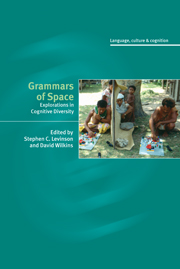Book contents
- Frontmatter
- Contents
- List of figures
- List of tables
- List of contributors
- Preface
- 1 The background to the study of the language of space
- 2 Towards an Arrernte grammar of space
- 3 Sketch of a Jaminjung grammar of space
- 4 Prolegomenon to a Warrwa grammar of space
- 5 The language of space in Yélî Dnye
- 6 Prolegomena to a Kilivila grammar of space
- 7 A sketch of the grammar of space in Tzeltal
- 8 Spatial reference in Yukatek Maya: a survey
- 9 Approaching space in Tiriyó grammar
- 10 Elements of the grammar of space in Ewe
- 11 Spatial language in Tamil
- 12 A grammar of space in Japanese
- 13 Some properties of spatial description in Dutch
- 14 Patterns in the data: towards a semantic typology of spatial description
- Appendices
- References
- Author index
- Language/Language family index
- Subject index
5 - The language of space in Yélî Dnye
Published online by Cambridge University Press: 22 September 2009
- Frontmatter
- Contents
- List of figures
- List of tables
- List of contributors
- Preface
- 1 The background to the study of the language of space
- 2 Towards an Arrernte grammar of space
- 3 Sketch of a Jaminjung grammar of space
- 4 Prolegomenon to a Warrwa grammar of space
- 5 The language of space in Yélî Dnye
- 6 Prolegomena to a Kilivila grammar of space
- 7 A sketch of the grammar of space in Tzeltal
- 8 Spatial reference in Yukatek Maya: a survey
- 9 Approaching space in Tiriyó grammar
- 10 Elements of the grammar of space in Ewe
- 11 Spatial language in Tamil
- 12 A grammar of space in Japanese
- 13 Some properties of spatial description in Dutch
- 14 Patterns in the data: towards a semantic typology of spatial description
- Appendices
- References
- Author index
- Language/Language family index
- Subject index
Summary
The language and culture of Rossel Island
Rossel Island lies at the eastern end of the Louisiade Archipelago, the last landfall in Milne Bay Province, Papua New Guinea. Its remote location in difficult seas has limited outside influence, nevertheless Rossel has always been part of a wider island network, for example feeding shell necklaces into the Kula ring. Before the Second World War, one Australian family ran a coconut plantation there for forty years. Since the war, Rossel labour has been used on the mainland, and the United and Catholic churches have run effective mission stations, bringing primary education in English to most children. Trade stores are badly supplied, and Rossel belongs only marginally to the cash economy, producing small amounts of copra and sea produce. Subsistence agriculture is based especially on sago, taro and yams, with protein from the sea. The population stands at about 4,000.
Both the language and the culture of Rossel are distinct from the Austronesian cultures on surrounding islands. Rossel canoes, houses, song styles, traditional dress and ornament are all distinctively alien to the surrounding peoples, and the language is regarded as unlearnable by outsiders. Rossel culture is built on a matrilineal clan system with theoretical ownership of land and sacred places running in the matriline, but with practical inheritance of land based on patrilocal residence in small hamlets. It has a renowned system of shell money, the focus of anthropological investigations by Armstrong (1928) and Liep (1981, 1983, 1989a, b).
- Type
- Chapter
- Information
- Grammars of SpaceExplorations in Cognitive Diversity, pp. 157 - 205Publisher: Cambridge University PressPrint publication year: 2006
- 12
- Cited by

